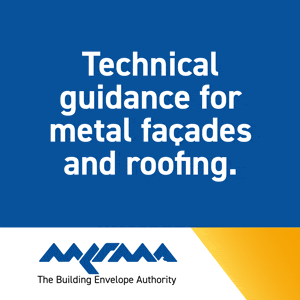Consider a product’s embodied carbon
- Specify & Build
- Jan 11, 2024
- 4 min read
Embodied carbon emissions will continue to increase as global demand for construction materials grows. Rebecca Goldsmith from MEDITE SMARTPLY explains why using wood-derived products can help reduce upfront carbon while designing with whole-life carbon in mind.
A decade ago, embodied carbon was simply not a consideration for most architectural designs, because any carbon incorporated in the construction materials was dwarfed by the carbon emitted by the building in operation.
Now, as buildings become increasingly energy efficient and operational carbon decreases, the quantity of carbon embodied in their construction is becoming a much more significant proportion of total emissions.
According to the World Green Building Council, carbon emissions released during the manufacture, transportation, construction and end-of-life-phases of a building “contribute around 11% of all global carbon emissions”. This means reducing embodied carbon is an important next step in the drive towards minimising overall carbon emissions from the built environment.
Material choice has a significant impact on a building’s embodied carbon, so it makes sense to incorporate low-embodied-carbon materials, such as wood-based panel products, into a building's design.
Wood-based products typically have significantly less energy-intensive manufacturing processes compared to those of alternatives such as steel or concrete. There is a short-term release of carbon when harvesting timber and from the decay of the residual root system and a loss of soil carbon. However, if the forest is sustainably managed and replanted, these emissions will soon be overtaken by the uptake of carbon in the soil and the new trees. Fast-growing trees, such as those used by MEDITE SMARTPLY to provide pulpwood thinnings for its panel-products, mature in just 15 to 20 years.

Timber products consume less carbon in their manufacturing stage, and there is an added bonus in that the timber itself stores carbon in the form of biogenic (or sequestered) carbon. This is the atmospheric carbon dioxide (CO2) absorbed by the tree as it grows.
Biogenic carbon is beneficial because, while it is locked up in the chemical composition of the wood, it is kept out of the atmosphere until the end of the product's life. For structural timber used in modern constructions, this is effectively a readily available carbon store for at least the next 60 years – the recognised lifespan of a building, although in reality that lifespan is likely to be significantly longer.
MEDITE SMARTPLY has invested in detailed Life Cycle Analysis (LCA) analysis into its wood panel products, including their embodied carbon. The average amount of biogenic carbon typically sequestered has been calculated as approximately 0.9 tCO2e per m3 of MDF and approximately 1.0 tCO2e per m3 of OSB product.
This figure is only accurate for the products tested and will vary across manufacturers and across product ranges, based on details such as the country of origin, its specific dry wood content and the density of wood in the product. Specific information can be found on each product's Environmental Product Declaration (EPD), which should be produced in accordance with the standard BS EN 15804:2012+A2:2019.
For wood-based products to confidently substantiate any carbon claims, the timber must be sustainably sourced from well-managed forests. According to DEFRA’s new Timber Roadmap, published in December 2023, some 80% of the UK’s wood is currently imported. The wood is mostly brought in from Europe, but some travels from as far away as North and South America. The carbon emissions associated with this transport will make up the largest proportion of emissions for products travelling a significant distance.
MEDITE SMARTPLY sources timber from its own forests in Ireland, which are sustainably managed by its parent company, Coillte and independently certified by both the Forest Stewardship Council (FSC) and Programme for the Endorsement of Forest Certification (PEFC).
The vast majority of the timber used in the manufacture of MEDITE SMARTPLY’s MDF and OSB panel products is a byproduct of both the sawmill industry (wood chip) and of good forest management. This forest management provides small diameter timber logs harvested when thinning forests, which eliminates waste and delays the upfront release of sequestered CO2. The company also uses wood waste as fuel in its OSB manufacturing plant.
80% of the UK’s wood is currently imported
To trace the wood's journey from forest to distribution, specifiers should refer to Chain of Custody certification. It ensures that customers receive wood-panel products that are from legal, environmentally appropriate, socially beneficial and economically viable forests.
Another benefit of using sustainably sourced timber is that the carbon sequestered within the product can be considered as part of a Whole Life Carbon (WLC) assessment for a building project.
There are four main stages in a building's WLC assessment: Product (Modules A1-A5); Use (B1-B7); Deconstruction (C1-C4); and Benefits beyond the Building Lifecycle (D), for example heat recovered from burning biomass. However, data from ‘D’ is not included in the overall WLC calculation.
Sequestered carbon is included in the product stage (A1) as a negative quantity and is termed as ‘stored carbon’ in the assessment. However, if the timber is not sustainably sourced, then its sequestered carbon cannot be considered in the WLC figure.
The whole issue of embodied carbon is still relatively new and there are many variations in the way it is expressed and calculated. Specifiers need to look carefully at EPDs of individual products to understand exactly what is included in the embodied carbon calculation in order to make informed product comparisons.
Gradually, calculations are starting to reveal the impact of material choice on the embodied carbon for individual buildings. MEDITE SMARTPLY is very confident that as more of the comparisons appear, the case for increasing the use of wood-based materials will become more and more compelling and we are keen to see a single standard calculation method become widely adopted.
.png)



























































.png)

